Stiffness Evaluation of Laboratory and Plant Produced Foamed Bitumen Warm Asphalt Mixtures with Fiber Reinforcement and Bio-Flux Additive
Abstract
:1. Introduction
2. Materials and Methods
2.1. Asphalt Mixtures
2.2. Asphalt Binders
2.3. Complex Stiffness Modulus Testing
3. Results
3.1. Laboratory Produced Mixtures
3.2. Plant Produced Mixtures
4. Discussion
5. Conclusions
- − fiber reinforcement in HMAs resulted in an increase in the dynamic moduli of both AC-S and HMAC mixtures,
- − the fiber reinforced WMA mixtures exhibited lower dynamic moduli than the HMA mixtures, in both laboratory and plant produced variants,
- − the compaction temperature of the WMA mixtures was not a statistically significant effect in terms of their complex stiffness modulus |E*|,
- − the respective plant and laboratory mixtures performed similarly in most cases – except for the AC-S mix.
Author Contributions
Funding
Institutional Review Board Statement
Informed Consent Statement
Data Availability Statement
Conflicts of Interest
References
- OECD. Transport Bridging Divides; OECD Urban Studies; OECD: Paris, France, 2020; ISBN 9789264747067. [Google Scholar]
- Banerjee, A.; Duflo, E.; Qian, N. On the road: Access to transportation infrastructure and economic growth in China. J. Dev. Econ. 2020, 145. [Google Scholar] [CrossRef] [Green Version]
- Varjan, P.; Rovňaníková, D.; Gnap, J. Examining Changes in GDP on the Demand for Road Freight Transport. Procedia Eng. 2017, 192, 911–916. [Google Scholar] [CrossRef]
- Danesi, A.; Ongari, D.; Poliziani, C.; Rupi, F. Evolution of the road and rail transport of goods in european countries before and after the financial crises. Commun.-Sci. Lett. Univ. Žilina 2019, 21, 3–12. [Google Scholar] [CrossRef]
- Elem, A.; Ejem, B. Estimating the Relationship Between Gdp and Freight Transport Volumes in Ecowas Nations. Int. J. Geogr. Reg. Plan. Res. 2020, 5, 39–49. [Google Scholar]
- Chomicz-Kowalska, A.; Maciejewski, K.; Iwański, M.M.; Janus, K. Effects of zeolites and hydrated lime on volumetrics and moisture resistance of foamed warm mix asphalt concrete. Bull. Polish Acad. Sci. Tech. Sci. 2021. [Google Scholar] [CrossRef]
- Woszuk, A.; Panek, R.; Madej, J.; Zofka, A.; Franus, W. Mesoporous silica material MCM-41: Novel additive for warm mix asphalts. Constr. Build. Mater. 2018, 183, 270–274. [Google Scholar] [CrossRef]
- Zhang, Y.; Leng, Z.; Zou, F.; Wang, L.; Chen, S.S.; Tsang, D.C.W. Synthesis of zeolite A using sewage sludge ash for application in warm mix asphalt. J. Clean. Prod. 2018, 172, 686–695. [Google Scholar] [CrossRef]
- Ahmadzadegan, F.; Sarkar, A. Mechanical properties of warm mix asphalt-stone matrix asphalt modified with nano zeolite material. J. Test. Eval. 2022, 50, 20200595. [Google Scholar] [CrossRef]
- Yin, F.; Arambula, E.; Newcomb, D.E. Effect of water content on binder foaming characteristics and foamed mixture properties. Transp. Res. Rec. 2015, 2506, 1–7. [Google Scholar] [CrossRef]
- Iwański, M.; Chomicz-Kowalska, A.; Mazurek, G.; Buczyński, P.; Cholewińska, M.; Iwański, M.M.; Maciejewski, K.; Ramiączek, P. Effects of the Water-Based Foaming Process on the Basic and Rheological Properties of Bitumen 70/100. Materials 2021, 14, 2803. [Google Scholar] [CrossRef]
- Behnood, A. A review of the warm mix asphalt (WMA) technologies: Effects on thermo-mechanical and rheological properties. J. Clean. Prod. 2020, 259, 120817. [Google Scholar] [CrossRef]
- Polo-Mendoza, R.; Peñabaena-Niebles, R.; Giustozzi, F.; Martinez-Arguelles, G. Eco-friendly design of Warm mix asphalt (WMA) with recycled concrete aggregate (RCA): A case study from a developing country. Constr. Build. Mater. 2022, 326, 126890. [Google Scholar] [CrossRef]
- Wu, S.; Zhang, W.; Shen, S.; Muhunthan, B. Field Performance of Foaming Warm Mix Asphalt Pavement. Transp. Res. Rec. 2019, 2673, 281–294. [Google Scholar] [CrossRef]
- Chomicz-Kowalska, A.; Gardziejczyk, W.; Iwański, M.M. Moisture resistance and compactibility of asphalt concrete produced in half-warm mix asphalt technology with foamed bitumen. Constr. Build. Mater. 2016, 126. [Google Scholar] [CrossRef] [Green Version]
- West, R.; Rodezno, C.; Julian, G.; Prowell, B.; Frank, B.; Osborn, L.V.; Kriech, T. Field Performance of Warm Mix Asphalt Technologies; National Academies: Washington, DC, USA, 2014. [Google Scholar]
- Yin, F.; Arámbula-Mercado, E.; Newcomb, D. Effect of laboratory foamer on asphalt foaming characteristics and foamed mixture properties. Int. J. Pavement Eng. 2017, 18, 358–366. [Google Scholar] [CrossRef]
- Maciejewski, K.; Chomicz-Kowalska, A. Foaming Performance and FTIR Spectrometric Analysis of Foamed Bituminous Binders Intended for Surface Courses. Materials 2021, 14, 2055. [Google Scholar] [CrossRef] [PubMed]
- Iwański, M.; Mazurek, G.; Buczyński, P.; Zapała-Sławeta, J. Multidimensional analysis of foaming process impact on 50/70 bitumen ageing. Constr. Build. Mater. 2021, 266, 121231. [Google Scholar] [CrossRef]
- Maciejewski, K.; Ramiaczek, P.; Remisova, E. Effects of short-term ageing temperature on conventional and high-temperature properties of paving-grade bitumen with anti-stripping and wma additives. Materials 2021, 14, 6229. [Google Scholar] [CrossRef]
- Pucułek, M.; Liphardt, A.; Radziszewski, P. Evaluation of the possibility of reduction of highly modified binders technological temperatures. Arch. Civ. Eng. 2021, 67, 557–570. [Google Scholar] [CrossRef]
- Król, J.B.; Niczke, Ł.; Kowalski, K.J. Towards understanding the polymerization process in Bitumen bio-fluxes. Materials 2017, 10, 1058. [Google Scholar] [CrossRef] [Green Version]
- Gawel, I.; Pilat, J.; Radziszewski, P.; Niczke, L.; Krol, J.; Sarnowski, M. Bitumen fluxes of vegetable origin. Polimery/Polymers 2010, 55, 55–60. [Google Scholar] [CrossRef] [Green Version]
- Somé, S.C.; Gaudefroy, V.; Delaunay, D. Effect of vegetable oil additives on binder and mix properties: Laboratory and field investigation. Mater. Struct. Constr. 2016, 49, 2197–2208. [Google Scholar] [CrossRef]
- Rasman, M.; Hassan, N.A.; Hainin, M.R.; Putra Jaya, R.; Haryati, Y.; Shukry, N.A.M.; Abdullah, M.E.; Kamaruddin, N.H.M. Engineering properties of bitumen modified with bio-oil. MATEC Web Conf. 2018, 250. [Google Scholar] [CrossRef]
- Elahi, Z.; Jakarni, F.M.; Muniandy, R.; Hassim, S.; Ab Razak, M.S.; Ansari, A.H.; Ben Zair, M.M. Waste cooking oil as a sustainable bio modifier for asphalt modification: A review. Sustainability 2021, 13, 1506. [Google Scholar] [CrossRef]
- Ahmed, R.B.; Hossain, K. Waste cooking oil as an asphalt rejuvenator: A state-of-the-art review. Constr. Build. Mater. 2020, 230. [Google Scholar] [CrossRef]
- Zaumanis, M.; Mallick, R.B.; Poulikakos, L.; Frank, R. Influence of six rejuvenators on the performance properties of Reclaimed Asphalt Pavement (RAP) binder and 100% recycled asphalt mixtures. Comput. Chem. Eng. 2014, 71, 538–550. [Google Scholar] [CrossRef]
- Ragni, D.; Ferrotti, G.; Lu, X.; Canestrari, F. Effect of temperature and chemical additives on the short-term ageing of polymer modified bitumen for WMA. Mater. Des. 2018, 160, 514–526. [Google Scholar] [CrossRef]
- Hofko, B.; Cannone Falchetto, A.; Grenfell, J.; Huber, L.; Lu, X.; Porot, L.; Poulikakos, L.D.; You, Z. Effect of short-term ageing temperature on bitumen properties. Road Mater. Pavement Des. 2017, 18, 108–117. [Google Scholar] [CrossRef] [Green Version]
- Frigio, F.; Raschia, S.; Steiner, D.; Hofko, B.; Canestrari, F. Aging effects on recycled WMA porous asphalt mixtures. Constr. Build. Mater. 2016, 123, 712–718. [Google Scholar] [CrossRef]
- Barraj, F.; Khatib, J.; Castro, A.; Elkordi, A. Effect of Chemical Warm Mix Additive on the Properties and Mechanical Performance of Recycled Asphalt Mixtures. Buildings 2022, 12, 874. [Google Scholar] [CrossRef]
- Yang, S.L.; Baek, C.; Park, H.B. Effect of aging and moisture damage on fatigue cracking properties in asphalt mixtures. Appl. Sci. 2021, 11, 543. [Google Scholar] [CrossRef]
- Wu, S.; Shen, S.; Zhang, W.; Muhunthan, B. Characterization of Long-term Performance of Warm Mix Asphalt in the United States. In Proceedings of the 7th Eurasphalt & Eurobitume Congress v1.0, Online, 15–17 June 2021; Foundation Eurasphalt: Madrid, Spain, 2021. [Google Scholar]
- Ayberk, Ö.; Zeliha, T.; Muhammet, K.; Seyit, A.Y. Investigation of field performance of warm mix asphalt produced with foamed bitumen. In Proceedings of the 7th Eurasphalt & Eurobitume Congress v1.0, Online, 15–17 June 2021; Foundation Eurasphalt: Madrid, Spain, 2021. [Google Scholar]
- Abtahi, S.M.; Sheikhzadeh, M.; Hejazi, S.M. Fiber-reinforced asphalt-concrete—A review. Constr. Build. Mater. 2010, 24, 871–877. [Google Scholar] [CrossRef]
- Wu, S.; Ye, Q.; Li, N.; Yue, H. Effects of fibers on the dynamic properties of asphalt mixtures. J. Wuhan Univ. Technol. Sci. Ed. 2007, 22, 733–736. [Google Scholar] [CrossRef]
- Krayushkina, K.; Prentkovskis, O.; Bieliatynskyi, A.; Gigineishvili, J.; Skrypchenko, A.; Laurinavičius, A.; Gopalakrishnan, K.; Tretjakovas, J. Perspectives on using basalt fiber filaments in the construction and rehabilitation of highway pavements and airport runways. Balt. J. Road Bridg. Eng. 2016, 11, 77–83. [Google Scholar] [CrossRef]
- Kaloush, K.E.; Biligiri, K.P.; Zeiada, W.A.; Rodezno, M.C.; Reed, J.X. Evaluation of fiber-reinforced asphalt mixtures using advanced material characterization tests. J. Test. Eval. 2010, 38. [Google Scholar] [CrossRef] [Green Version]
- Enieb, M.; Diab, A.; Yang, X. Short- and long-term properties of glass fiber reinforced asphalt mixtures. Int. J. Pavement Eng. 2021, 22, 64–76. [Google Scholar] [CrossRef]
- Alidadi, M.; Khabiri, M.M. Experimental Study on the Effect of Glass and Carbon Fibers on Physical and Micro-Structure Behavior of Asphalt. Int. J. Integr. Eng. 2016, 8, 1–8. [Google Scholar]
- Ziari, H.; Orouei, M.; Divandari, H.; Yousefi, A. Mechanical characterization of warm mix asphalt mixtures made with RAP and Para-fiber additive. Constr. Build. Mater. 2021, 279. [Google Scholar] [CrossRef]
- Fakhri, M.; Hosseini, S.A. Laboratory evaluation of rutting and moisture damage resistance of glass fiber modified warm mix asphalt incorporating high RAP proportion. Constr. Build. Mater. 2017, 134, 626–640. [Google Scholar] [CrossRef]
- Mohammed Alnadish, A.; Yusri Aman, M.; Yati Binti Katman, H.; Rasdan Ibrahim, M. Laboratory Evaluation of Fiber-Modified Asphalt Mixtures Incorporating Steel Slag Aggregates. Comput. Mater. Contin. 2022, 70, 5967–5990. [Google Scholar] [CrossRef]
- WT-2 2014. Asphalt mixes. Technical Requirements. Appendix to ordinance No. 54 of the General Director of National Roads and Highways, 8.11.2014. 2014.
- Iwański, M.; Chomicz-Kowalska, A.; Maciejewski, K.; Iwański, M.M.; Radziszewski, P.; Liphardt, A.; Król, J.B.; Sarnowski, M.; Kowalski, K.J.; Pokorski, P. Warm Mix Asphalt Binder Utilizing Water Foaming and Fluxing Using Bio-Derived Agent. Materials 2022, 15, 8873. [Google Scholar] [CrossRef] [PubMed]
- Iwański, M.; Chomicz-Kowalska, A.; Maciejewski, K.; Iwański, M.M.; Radziszewski, P.; Liphardt, A.; Król, J.B.; Sarnowski, M.; Kowalski, K.J.; Pokorski, P. Effects of Laboratory Ageing on the FTIR Measurements of Water-Foamed Bio-Fluxed Asphalt Binders. Materials 2023, 16, 513. [Google Scholar] [CrossRef]
- Airey, G.D.; Rahimzadeh, B.; Collop, A.C. Viscoelastic linearity limits for bituminous materials. Mater. Struct. 2003, 36, 643–647. [Google Scholar] [CrossRef]
- Jaczewski, M.; Judycki, J.; Jaskula, P. Asphalt concrete subjected to long-time loading at low temperatures – Deviations from the time-temperature superposition principle. Constr. Build. Mater. 2019, 202, 426–439. [Google Scholar] [CrossRef]
- Zhang, Y.; Zhu, Y.; Wang, W.; Ning, Z.; Feng, S.; Höeg, K. Compressive and tensile stress–strain-strength behavior of asphalt concrete at different temperatures and strain rates. Constr. Build. Mater. 2021, 311. [Google Scholar] [CrossRef]
- Buczyński, P.; Iwański, M. Complex modulus change within the linear viscoelastic region of the mineral-cement mixture with foamed bitumen. Constr. Build. Mater. 2018, 172, 52–62. [Google Scholar] [CrossRef]
- Mazurek, G.; Iwański, M. Modelling of Asphalt Concrete Stiffness in the Linear Viscoelastic Region. IOP Conf. Ser. Mater. Sci. Eng. 2017, 245, 032029. [Google Scholar] [CrossRef]
- Nur, N.I.; Chailleux, E.; Airey, G.D. A comparative study of the influence of shift factor equations on master curve construction. Int. J. Pavement Res. Technol. 2011, 4, 324–336. [Google Scholar]
- Medani, T.O.; Tech, M.; Huurman, M. Constructing the Stiffness Master Curves for Asphaltic Mixes. Civ. Eng. 2003, 1–21. [Google Scholar]
- Pellinen, T.K.; Witczak, M.W.; Bonaquist, R.F. Asphalt Mix Master Curve Construction Using Sigmoidal Fitting Function with Non-Linear Least Squares Optimization. In Recent Advances in Materials Characterization and Modeling of Pavement Systems; Purdue University: West Lafayette, IN, USA, 2003; pp. 83–101. [Google Scholar] [CrossRef]
- Li, J.; Zofka, A.; Yut, I. Evaluation of dynamic modulus of typical asphalt mixtures in Northeast US Region. Road Mater. Pavement Des. 2012, 13, 249–265. [Google Scholar] [CrossRef]
- Singh, D.; Zaman, M.; Commuri, S. Evaluation of predictive models for estimating dynamic modulus of hot-mix asphalt in Oklahoma. Transp. Res. Rec. 2011, 57–72. [Google Scholar] [CrossRef]
- Al-Khateeb, G.; Shenoy, A.; Gibson, N.; Harman, T. A new simplistic model for dynamic modulus predictions of asphalt paving mixtures. In Proceedings of the 2006 Annual Meeting of Association of Asphalt Paving Technologists, Savannah, GA, USA, 27–29 March 2006. [Google Scholar]
- Hofko, B.; Blab, R.; Mader, M. Impact of air void content on the viscoelastic behavior of hot mix asphalt; Taylor and Francis Group: London, UK, 2012; pp. 139–149. [Google Scholar] [CrossRef]
- Williams, S.G.; Braham, A.F. Foamed Warm Mix Asphalt Design Issues; University of Arkansas: Fayetteville, AR, USA, 2015. [Google Scholar]
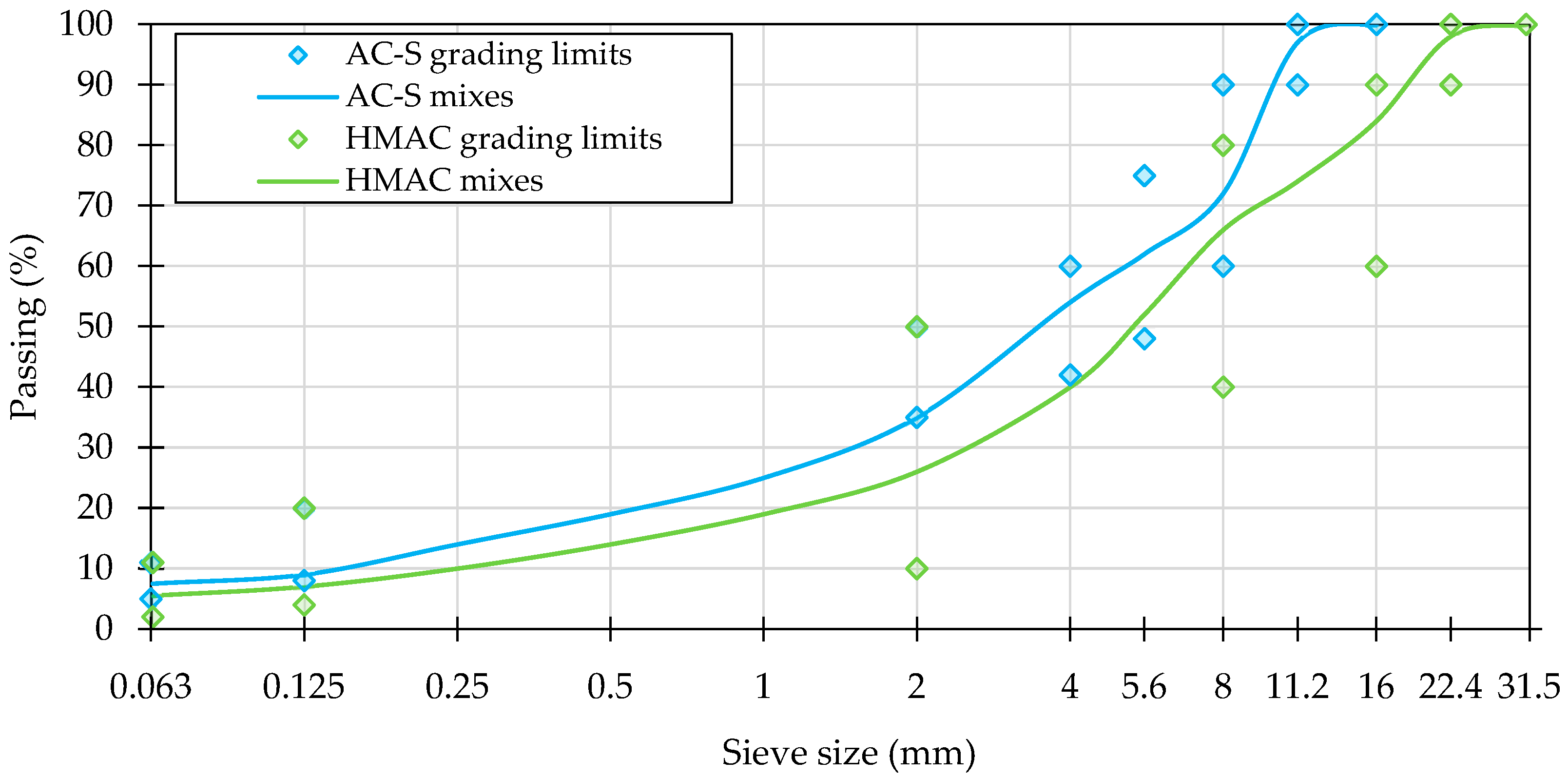





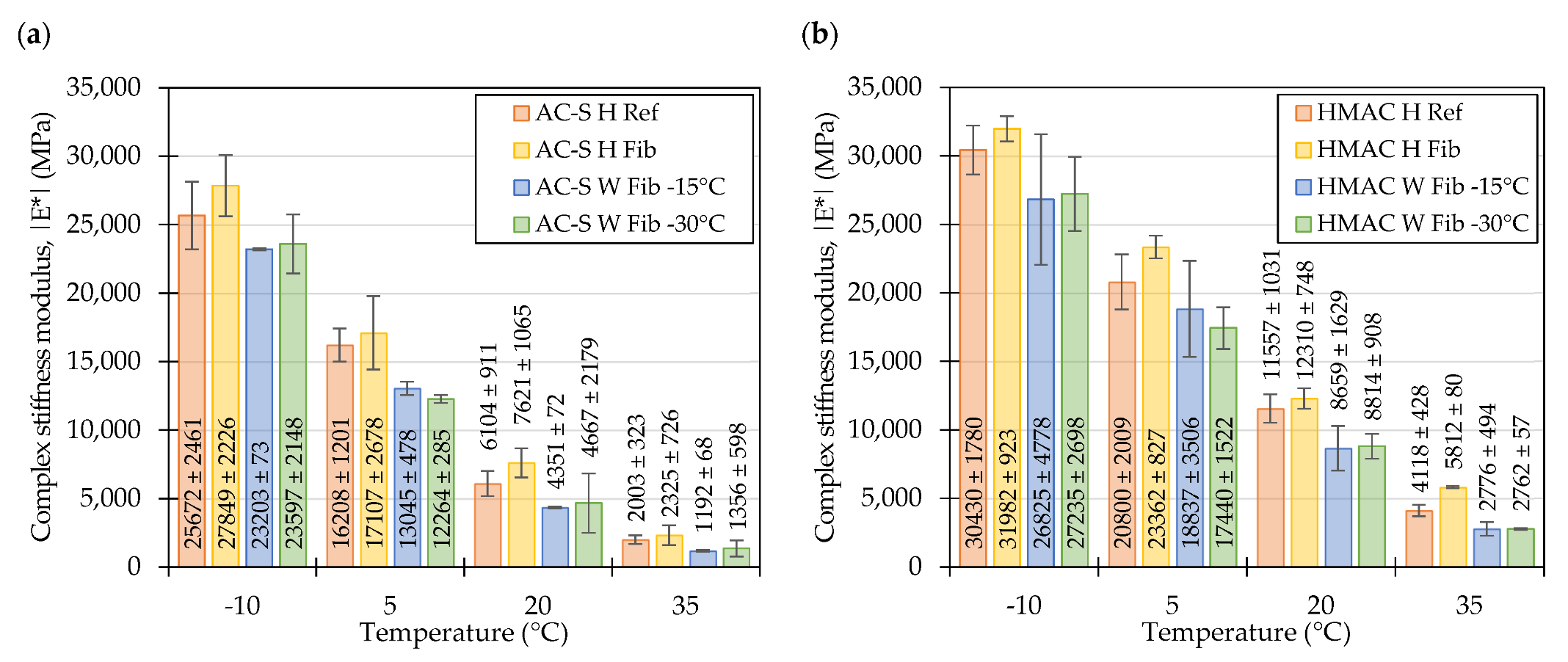
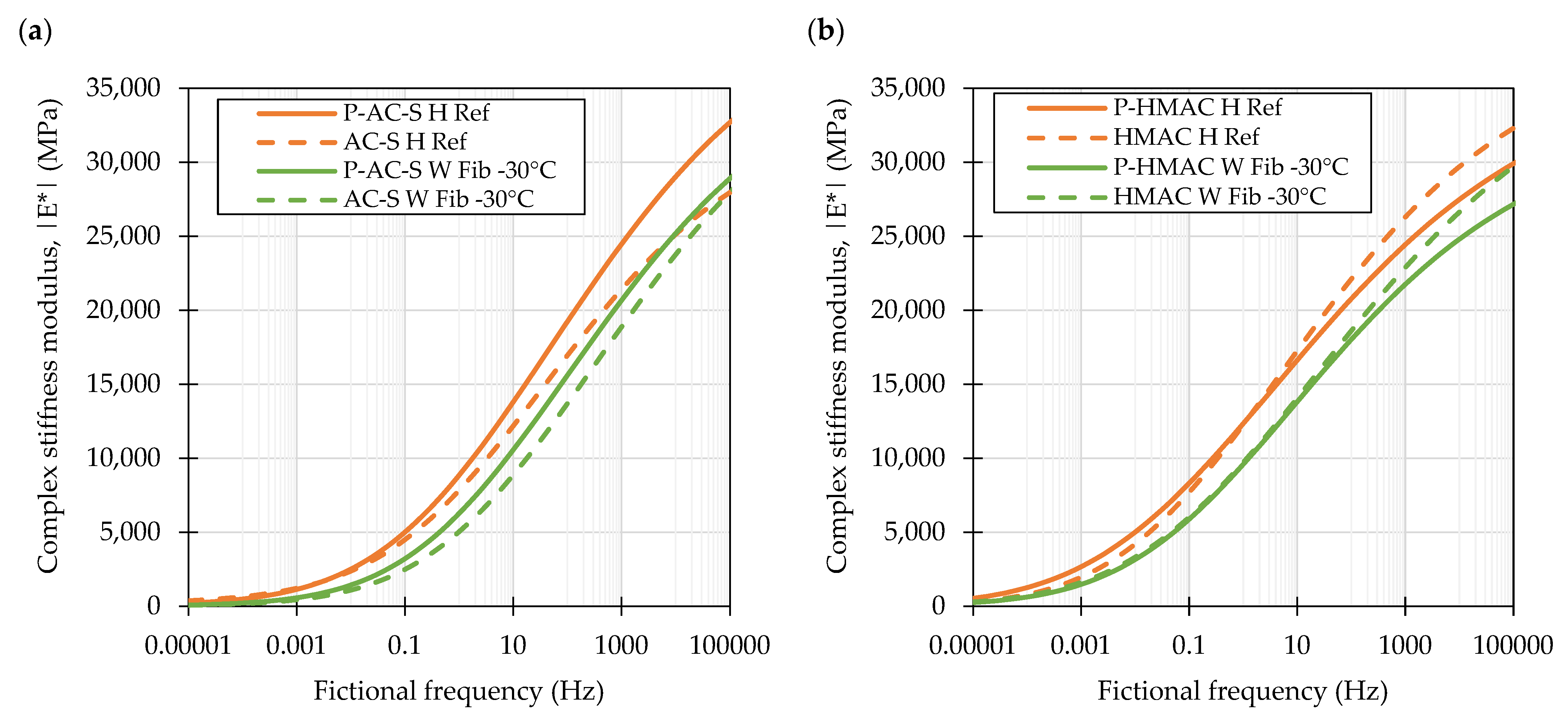
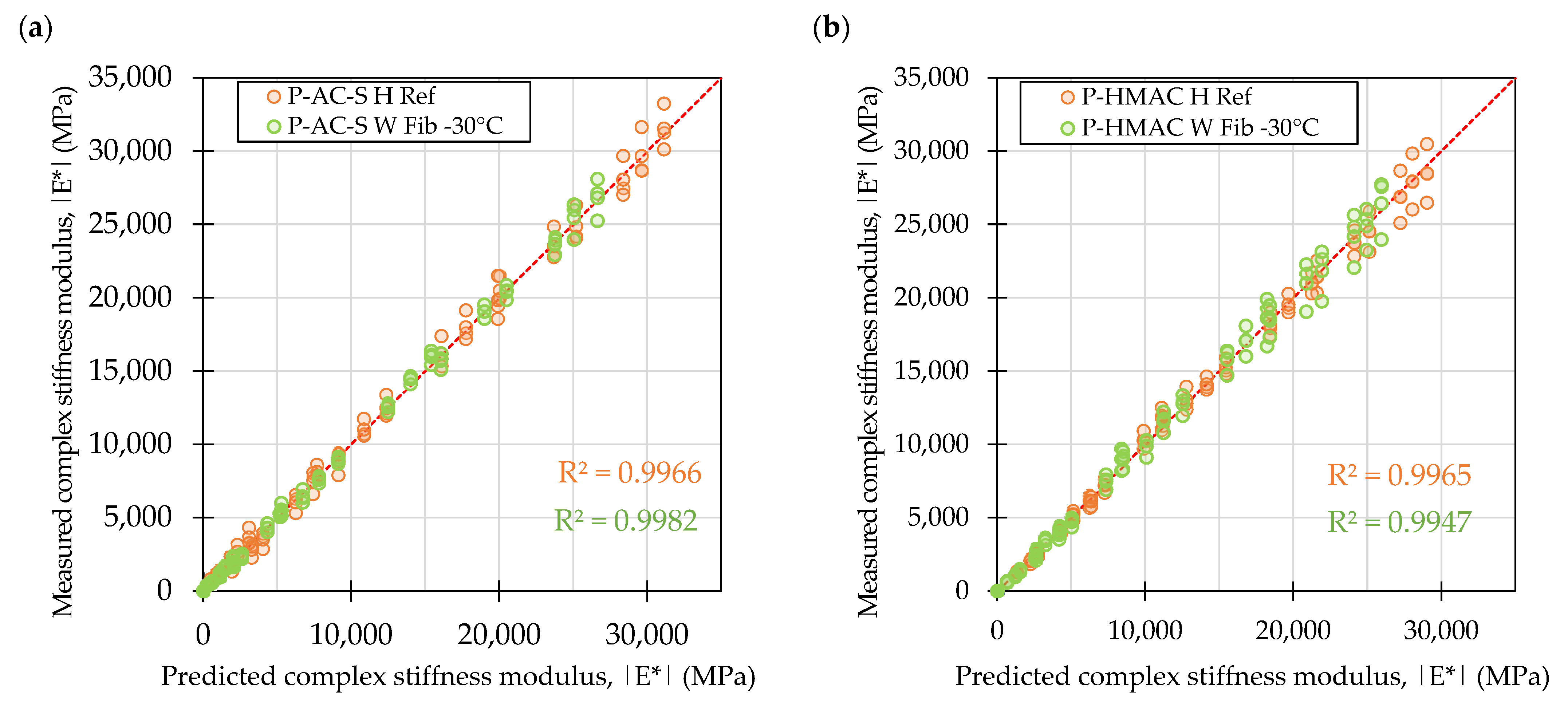
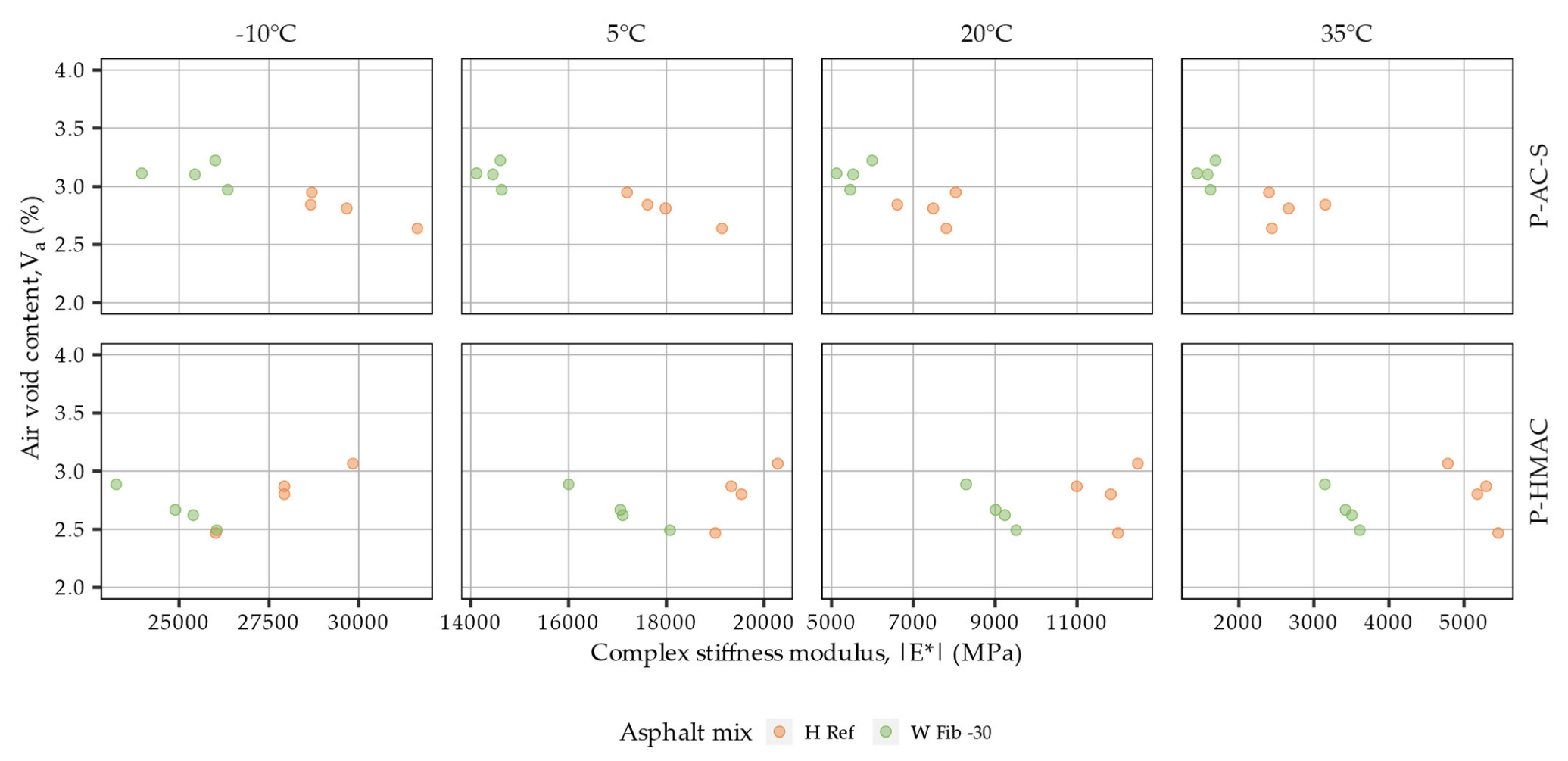

| Mixture Designation | Mix Type | Fibers Added | Production Technique | Compaction Temperature (°C) | Mix Production |
|---|---|---|---|---|---|
| AC-S H Ref | AC-S | No | HMA | 145 | Laboratory |
| AC-S H Fib | AC-S | Yes | HMA | 145 | Laboratory |
| AC-S W Fib-15 | AC-S | Yes | WMA | 130 (−15) | Laboratory |
| AC-S W Fib-30 | AC-S | Yes | WMA | 115 (−30) | Laboratory |
| HMAC H Ref | HMAC | No | HMA | 145 | Laboratory |
| HMAC H Fib | HMAC | Yes | HMA | 145 | Laboratory |
| HMAC W Fib-15 | HMAC | Yes | WMA | 130 (−15) | Laboratory |
| HMAC W Fib-30 | HMAC | Yes | WMA | 115 (−30) | Laboratory |
| P-AC-S H Ref | AC-S | No | HMA | 145 | Plant (no STOA) |
| P-AC-S W Fib-30 | AC-S | Yes | WMA | 115 (−30) | Plant (no STOA) |
| P-HMAC H Ref | HMAC | No | HMA | 145 | Plant (no STOA) |
| P-HMAC W Fib-30 | HMAC | Yes | WMA | 115 (−30) | Plant (no STOA) |
| AC-S Ref Mixes | AC-S Fib Mixes | HMAC Ref Mixes | HMAC Fib Mixes | |
|---|---|---|---|---|
| Nominal maximum aggregate size (mm) | 11 | 11 | 22 | 22 |
| Mineral mix density, ρa (Mg/m3) | 2.855 | 2.855 | 2.705 | 2.705 |
| Filler, limestone (%) | 5.7 | 5.7 | 3.8 | 3.8 |
| Limestone, 0/2 mm (%) | 18.0 | 18.0 | - | - |
| Limestone, 0/4 mm (%) | 14.1 | 14.1 | - | - |
| Gabbro, 2/5 mm (%) | 18.0 | 18.0 | - | - |
| Gabbro, 4/8 mm (%) | 12.2 | 12.2 | - | - |
| Gabbro, 8/11 mm (%) | 26.3 | 26.3 | - | - |
| Limestone, 0/2 mm (%) | - | - | 9.5 | 9.5 |
| Limestone, 0/4 mm (%) | - | - | 19.0 | 19.0 |
| Limestone, 2/8 mm (%) | - | - | 29.2 | 29.2 |
| Limestone, 8/16 mm (%) | - | - | 18.1 | 18.1 |
| Limestone, 16/22 mm (%) | - | - | 15.2 | 15.2 |
| Asphalt binder content (%, m/m) | 5.4 | 5.4 | 5.0 | 5.0 |
| Adhesion promoter, Wetfix BE, Minova Ekochem, (% per asphalt binder) | 0.3% | 0.3% | 0.3% | 0.3% |
| Basalt fibers, Basalttech Sp. z o.o. | - | 0.3% (12 mm) | - | 0.2% (24 mm) |
| AC-S H Mixes (HMA) | AC-S W Mixes (WMA) | HMAC H Mixes (HMA) | HMAC W Mixes (WMA) | |
|---|---|---|---|---|
| Asphalt binder type | 45/80-80 (neat) | Foamed 45/80-80 +3% Bio-Flux | 25/55-60 neat | Foamed 25/55-60 +2% Bio-Flux |
| Foaming water content (%) | - | 2.0 | - | 2.0 |
| STOA (2 h) temperature (°C) | 135 | 135 | 135 | 135 |
| Mixing temperature (°C) | 180 | 160 | 180 | 160 |
| Compaction temperature (°C) | 145 | 130, 115 | 145 | 130, 115 |
| Unit | AC-S Mix | HMAC Mix | Testing Method | |||
|---|---|---|---|---|---|---|
| 45/80-80 Neat | Foamed 45/80-80 +3% Bio-Flux | 25/55-60Neat | Foamed 25/55-60 +2% Bio-Flux | |||
| Penetration at 25 °C | 0.1 mm | 75 | 124 | 40 | 65 | EN 1426 |
| Softening point | °C | 95.5 | 81.2 | 63.4 | 58.0 | EN 1427 |
| Fraass breaking point | °C | −22 | −25 | −13 | −17 | EN 12593 |
| Dynamic viscosity at 135 °C | Pa·s | 2.81 | 1.31 | 1.70 | 1.21 | EN 13702–2 |
| Dynamic viscosity at 135 °C after RTFOT | Pa·s | 3.77 | 2.40 | 2.51 | 2.12 | EN 13702–2 |
| High critical temperature (G*/sin(δ) = 2.2 kPa) | °C | 81.3 | 83.1 | 78.9 | 77.6 | EN 14770, EN 12607-1 |
| Low critical temperature (S = 300 Mpa, m = 0.3) | °C | −22.2, −18.3 | −25.8, −22.1 | −19.2, −16.0 | −21.8,−18.9 | EN 14771, EN 12607-1 EN 14769 |
| Jnr 3.2 kPa at 60 °C | 1/kPa | 0.026 | 0.020 | 0.080 | 0.180 | EN 16659 |
| %R3.2 kPa | % | 96 | 96 | 70 | 61 | EN 16659 |
| Compared Pairs | Surface Course AC mix (AC-S) | High Stiffness Modulus AC Mix (HMAC) | |||||||
|---|---|---|---|---|---|---|---|---|---|
| Mix-1 | Mix-2 | −10 | 5 | 20 | 35 | −10 | 5 | 20 | 35 |
| H Ref | H Fib | 0.078 | 0.477 | 0.058 | 0.419 | 0.575 | 0.059 | 0.393 | <0.001 |
| H Ref | W Fib-15 | 0.042 | 0.001 | 0.027 | 0.008 | 0.044 | 0.179 | <0.001 | <0.001 |
| H Ref | W Fib-30 | 0.096 | <0.001 | 0.075 | 0.034 | 0.080 | 0.012 | <0.001 | <0.001 |
| H Fib | W Fib-15 | <0.001 | <0.001 | <0.001 | 0.001 | 0.005 | 0.001 | <0.001 | <0.001 |
| H Fib | W Fib-30 | 0.001 | <0.001 | 0.001 | 0.002 | 0.008 | 0.000 | <0.001 | <0.001 |
| W Fib-15 | W Fib-30 | 0.960 | 0.587 | 0.930 | 0.848 | 0.985 | 0.433 | 0.986 | 1.000 |
| Compared Pairs | Surface Course AC Mix (AC-S) | High Stiffness Modulus AC Mix (HMAC) | |||||||
|---|---|---|---|---|---|---|---|---|---|
| Mix-1 | Mix-2 | −10 | 5 | 20 | 35 | −10 | 5 | 20 | 35 |
| P-H Ref | H Ref | 0.004 | 0.004 | 0.104 | 0.019 | 0.091 | 0.230 | 0.904 | 0.000 |
| P-W Fib-30 | W Fib-30 | 0.229 | 0.001 | 0.425 | 0.625 | 0.120 | 0.927 | 0.960 | 0.004 |
| P-H Ref | P-W Fib-30 | 0.003 | 0.000 | 0.017 | 0.000 | 0.035 | 0.009 | 0.000 | 0.000 |
| P-H Ref | W Fib-30 | 0.000 | 0.000 | 0.001 | 0.000 | 0.884 | 0.025 | 0.000 | 0.000 |
| H Ref | P-W Fib-30 | 0.994 | 0.004 | 0.716 | 0.173 | 0.000 | 0.000 | 0.000 | 0.003 |
| H Ref | W Fib-30 | 0.155 | 0.000 | 0.087 | 0.022 | 0.026 | 0.001 | 0.000 | 0.000 |
Disclaimer/Publisher’s Note: The statements, opinions and data contained in all publications are solely those of the individual author(s) and contributor(s) and not of MDPI and/or the editor(s). MDPI and/or the editor(s) disclaim responsibility for any injury to people or property resulting from any ideas, methods, instructions or products referred to in the content. |
© 2023 by the authors. Licensee MDPI, Basel, Switzerland. This article is an open access article distributed under the terms and conditions of the Creative Commons Attribution (CC BY) license (https://creativecommons.org/licenses/by/4.0/).
Share and Cite
Iwański, M.; Chomicz-Kowalska, A.; Maciejewski, K.; Janus, K.; Radziszewski, P.; Liphardt, A.; Michalec, M.; Góral, K. Stiffness Evaluation of Laboratory and Plant Produced Foamed Bitumen Warm Asphalt Mixtures with Fiber Reinforcement and Bio-Flux Additive. Materials 2023, 16, 1950. https://doi.org/10.3390/ma16051950
Iwański M, Chomicz-Kowalska A, Maciejewski K, Janus K, Radziszewski P, Liphardt A, Michalec M, Góral K. Stiffness Evaluation of Laboratory and Plant Produced Foamed Bitumen Warm Asphalt Mixtures with Fiber Reinforcement and Bio-Flux Additive. Materials. 2023; 16(5):1950. https://doi.org/10.3390/ma16051950
Chicago/Turabian StyleIwański, Marek, Anna Chomicz-Kowalska, Krzysztof Maciejewski, Karolina Janus, Piotr Radziszewski, Adam Liphardt, Maciej Michalec, and Karol Góral. 2023. "Stiffness Evaluation of Laboratory and Plant Produced Foamed Bitumen Warm Asphalt Mixtures with Fiber Reinforcement and Bio-Flux Additive" Materials 16, no. 5: 1950. https://doi.org/10.3390/ma16051950
APA StyleIwański, M., Chomicz-Kowalska, A., Maciejewski, K., Janus, K., Radziszewski, P., Liphardt, A., Michalec, M., & Góral, K. (2023). Stiffness Evaluation of Laboratory and Plant Produced Foamed Bitumen Warm Asphalt Mixtures with Fiber Reinforcement and Bio-Flux Additive. Materials, 16(5), 1950. https://doi.org/10.3390/ma16051950








